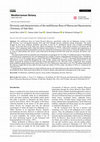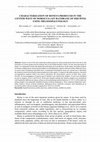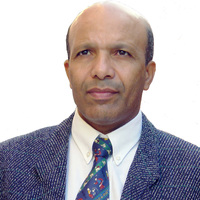Papers by Mohamed Alifriqui

Mediterranean botany, Apr 24, 2024
The melliferous flora of Central Western Morocco, specifically within the Ait Baâmrane territory ... more The melliferous flora of Central Western Morocco, specifically within the Ait Baâmrane territory of Sidi Ifni Province, was investigated between 2016 and 2018 through surveys conducted among beekeepers. The plants foraged by bees were collected, identified, and listed. A total of 117 melliferous species were recorded, constituting 41.64% of the total flora of the study area, which encompasses 281 species. These species belong to 98 genera and 40 families. The Compositae family claims the highest representation at 17.95%, followed by Lamiatae and Leguminosae at 6.84%. Among the identified geographical zones, the continental mountainous region (Zone C) boasts the highest diversity in terms of plant habitats and species count, followed by the plateau and hills zone (Zone B), and lastly, the littoral zone (Zone A). The region stands out for its remarkable rate of endemism, accounting for 20.51% of the 117 melliferous species. Nevertheless, several species are categorized as rare and endangered taxa, totaling 10 species. Regarding their biological types, Therophytes make up 36.75% of the foraged species, closely followed by Chamaephytes at 17.95%. Concerning flowering periods, the phenomenon occurs consistently throughout the year. Notably, spring is the dominant season, representing 42.45% of the plants, succeeded by summer at 28.98% and then winter and autumn at 15%, 10% and 13.47%, respectively. Bees strongly prefer melliferous plants adorned with yellow flowers (33.33%), followed by white flowers (30.77%). The plants mentioned in the study are sought after by bees either for their nectar and pollen (74.36%), solely for pollen (15.38%), or exclusively for nectar (8.55%). Considering the endangered status of certain melliferous species, this study underscores the critical importance of conserving the melliferous flora. Such conservation efforts are crucial to enhance and sustain the beekeeping sector in the region.

Applied Ecology and Environmental Research
Honey is one of the most important products given by nature produced by bees from nectar and hone... more Honey is one of the most important products given by nature produced by bees from nectar and honeydew of various plants used by humans due to the health benefits it offers. For the characterization of honey, it is important to know the plants that participate in its production. In this study, the pollen analysis of 9 honey samples from central-western Morocco (Ait Baâmrane region) collected in three different zones, A (coast zone), B (plateaus and hills) and C (continental mountainous area) was carried out to determine the botanical sources involved in honey production in this region. To improve the pollen analysis, a factorial correspondence analysis (AFC) was used to determine the characteristic species of these three zones. Overall, 35 taxa belonging to 33 genera and 22 families were found in the samples. 23 taxa were identified in zone A samples, 20 in C and 16 in B. Of the nine samples studied, the summer samples were monofloral with Euphorbia officinarum subsp. echinus as the predominant pollen (between 25.71% 71.42%) while the spring samples were generally multifloral honeys (without dominance). They contained Euphorbia regisjubae, Papaver rhoeas, Echium petiolatum, Diplotaxis harra, Glebionis coronaria, and Calendula sp. as secondary pollen with percentages ranging from 18.57% to 26.64%.
HAL (Le Centre pour la Communication Scientifique Directe), 2013
HAL is a multidisciplinary open access archive for the deposit and dissemination of scientific re... more HAL is a multidisciplinary open access archive for the deposit and dissemination of scientific research documents, whether they are published or not. The documents may come from teaching and research institutions in France or abroad, or from public or private research centers. L'archive ouverte pluridisciplinaire HAL, est destinée au dépôt et à la diffusion de documents scientifiques de niveau recherche, publiés ou non, émanant des établissements d'enseignement et de recherche français ou étrangers, des laboratoires publics ou privés.
Bois Et Forets Des Tropiques, 2017

Bois Et Forets Des Tropiques, 2010
In vitro culture and rooting of stem cuttings can be used for vegetative propagation of plant mat... more In vitro culture and rooting of stem cuttings can be used for vegetative propagation of plant material. Argan trees (Argania spinosa (L.) Skeels) are endemic to semi-desert areas of Southwestern Morocco, where they cover more than 8000 km 2 and have important socioeconomic and environmental impacts. Seed germination was improved by culturing in vitro isolated kernels on Murashige and Skoog (MS) axenic medium with 1.0 mg/L gibberellic acid (GA 3). Newly in vitro-produced seedlings were then transferred to MS medium containing 0.5 mg/L thidiazuron (TDZ) and 1.0 mg/L GA 3 to promote shoot development. The microcuttings produced were rooted using MS medium supplemented with two synthetic auxins, 1-naphthaleneacetic acid (NAA) and indole-3-butyric acid (IBA), at 1.0 mg/L each. The rooted microcuttings were then transplanted to soil and acclimated in a greenhouse environment. In addition, hardwood stem cuttings collected from adult argan trees were rooted by using a combination of IBA and NAA.
Soil Biology & Biochemistry, Sep 1, 2023
HAL (Le Centre pour la Communication Scientifique Directe), 2018
EBOOK [EPUB] gratit sur le site de l'éditeur.International audienc
La forêt est classiquement considérée comme un espace naturel, dont la gestion est soumise à des ... more La forêt est classiquement considérée comme un espace naturel, dont la gestion est soumise à des règles établies par une foresterie le plus souvent étatique, et dont les objectifs majeurs sont la production de bois et la protection de milieux forestiers aux services écosystémiques multiples. C’est aussi un espace investi par l’Homme, source de différentes ressources nécessaires au développement de sociétés rurales qui ont su les identifier, les interpréter, les favoriser, les façonner, voire ..

Ecology
Plant recruitment interactions (i.e., what recruits under what) shape the composition, diversity,... more Plant recruitment interactions (i.e., what recruits under what) shape the composition, diversity, and structure of plant communities. Despite the huge body of knowledge on the mechanisms underlying recruitment interactions among species, we still know little about the structure of the recruitment networks emerging in ecological communities. Modeling and analyzing the community‐level structure of plant recruitment interactions as a complex network can provide relevant information on ecological and evolutionary processes acting both at the species and ecosystem levels. We report a data set containing 143 plant recruitment networks in 23 countries across five continents, including temperate and tropical ecosystems. Each network identifies the species under which another species recruits. All networks report the number of recruits (i.e., individuals) per species. The data set includes >850,000 recruiting individuals involved in 118,411 paired interactions among 3318 vascular plant sp...

Kastamonu Üniversitesi Orman Fakültesi Dergisi
Aim of study: Aim was to characterize and analyses the vascular flora along coastal transect to c... more Aim of study: Aim was to characterize and analyses the vascular flora along coastal transect to continental of the Ait Baamrane region. Area of study: The territory of Ait Baâmrane is located in the South-central Morocco. Its location, in the nearness of the Atlantic Ocean, the Canary Islands, and the pre-Sahara, makes it a well-defined geographical entity where a large natural area is distinguished. Material and methods: The flora was characterized by the specific richness, the endemism and the conservation status. Further, plant diversity was evaluated by Shannon diversity, Evenness, disturbance and Jaccard similarity indices, as well as the plant functional groups were identified in three geographic zones; the littoral zone (A), the plateau’s zone (B), and the continental zone (C). Main results: The studied area highlighted an important floristic richness with 281 vascular species and subspecies. Therophytes are the most represented (43.42%). The endemic flora represented 21.35% ...
Les terroirs au Sud, vers un nouveau modèle ?, 2016
Introduction À travers le monde, l’arbre est souvent intégré dans les systèmes d’agriculture et d... more Introduction À travers le monde, l’arbre est souvent intégré dans les systèmes d’agriculture et d’élevage. Des agroforêts indonésiennes au bocage breton, en passant par les systèmes agro-sylvo-pastoraux méditerranéens et de montagne, l’arbre constitue un élément structurel des terroirs paysans (Michon, 2015). Selon les conditions environnementales locales, mais également selon les pratiques de gestion paysanne, l’arbre apparaît sous des formes diverses et variées et fournit de multiples biens..
Thierry GAUQUELIN IMBE, France Geneviève MICHON UMR GRED, IRD, France Richard JOFFRE CEFE, CNRS, ... more Thierry GAUQUELIN IMBE, France Geneviève MICHON UMR GRED, IRD, France Richard JOFFRE CEFE, CNRS, France Robin DUPONNOIS UMR LSTM, IRD, France Didier GÉNIN UMR LPED, IRD, France Bruno FADY URFM, INRA, France Magda BOU DAGHER Saint Joseph University, Lebanon Arezki DERRIDJ Tizi-Ouzou University,Algeria Said SLIMANI Tizi-Ouzou University,Algeria Wadi BADRI Casablanca University, Morocco Mohamed ALIFRIQUI Marrakech University, Morocco Laurent AUCLAIR UMR LPED, IRD, France Romain SIMENEL UMR LPED, IRD, France Mohamed ADERGHAL LMI MEDITER, Morocco Ezekiel BAUDOIN UMR LSTM, IRD, France Antoine GALIANA UMR LSTM, CIRAD, France Yves PRIN UMR LSTM, CIRAD, France Hervé SANGUIN UMR LSTM, CIRAD, France Catherine FERNANDEZ IMBE, France Virginie BALDY IMBE, France

Les questions que posaient le semis et le bouturage herbace de l'arganier sont presque resolu... more Les questions que posaient le semis et le bouturage herbace de l'arganier sont presque resolues. Il restait a mettre au point un itineraire technique pour multiplier vegetativement et rajeunir de vieux arganiers. Cette mobilisation ex situ de genotypes remarquables passe par la culture in vitro, le marcottage aerien (qui lui aussi est en passe d'etre regle), par l'induction du drageonnage, par le bouturage de segments racinaires et par l'amelioration du greffage. Pour cette derniere technique, on se basera notamment sur l'essai realise sur pres de 1 000 greffes dans le cadre du " Projet de clonage d'arganiers âges " au Centre de Recherche Forestiere de Marrakech de 2007 a 2010. L'arganier reste une espece difficile a greffer quand on preleve des greffons sur des arganiers âges, surtout sous le climat de Marrakech. Il est excessivement rare de trouver des drageons apparaissant a plus de trois metres de l'arganier-mere. Par contre, au pied de ...
Les terroirs au Sud, vers un nouveau modèle ?, 2016
Introduction La forêt d’arganiers du Maroc est aujourd’hui reconnue comme un patrimoine naturel e... more Introduction La forêt d’arganiers du Maroc est aujourd’hui reconnue comme un patrimoine naturel emblématique du pays : l’ensemble de l’arganeraie a été classé comme réserve de biosphère de l’Unesco en 1998 ; son produit phare, l’huile d’argan, a réussi à se placer de façon durable sur la niche commerciale des produits « naturels et ethniques » et bénéficie de la première indication géographique sur le continent africain, et les « savoirs sur l’arganier » viennent d’être classés au Pat..
Applied Ecology and Environmental Research
Yous et al.: Effects of the continentality and the age of prickly pear (Opuntia ficus-indica (L.)... more Yous et al.: Effects of the continentality and the age of prickly pear (Opuntia ficus-indica (L.) Mill.) plantations on soil properties along a coastal and continental transect in a Pre-Saharan Region of South-Central Morocco (Ait Baamrane











Uploads
Papers by Mohamed Alifriqui